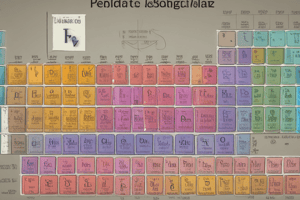Podcast
Questions and Answers
Which branch of chemistry deals with the physical properties of matter and its transformations?
Which branch of chemistry deals with the physical properties of matter and its transformations?
- Organic Chemistry
- Physical Chemistry (correct)
- Inorganic Chemistry
- Analytical Chemistry
What is the study of energy transformations and the relationships between heat, work, and energy in chemical systems called?
What is the study of energy transformations and the relationships between heat, work, and energy in chemical systems called?
- Thermodynamics (correct)
- Biochemistry
- Organic Chemistry
- Quantum Chemistry
Which area of physical chemistry focuses on predicting thermodynamic properties and kinetic behavior using probability theory?
Which area of physical chemistry focuses on predicting thermodynamic properties and kinetic behavior using probability theory?
- Quantum Mechanics
- Statistical Mechanics (correct)
- Kinetics
- Spectroscopy
What does spectroscopy primarily study in the realm of physical chemistry?
What does spectroscopy primarily study in the realm of physical chemistry?
Which field in physical chemistry focuses on the interactions between substances and electricity?
Which field in physical chemistry focuses on the interactions between substances and electricity?
What is the main purpose of the Periodic Table in chemistry?
What is the main purpose of the Periodic Table in chemistry?
How are elements grouped in the Periodic Table?
How are elements grouped in the Periodic Table?
What does the atomic number of an element represent?
What does the atomic number of an element represent?
How does physical chemistry relate to the Periodic Table?
How does physical chemistry relate to the Periodic Table?
Why is understanding physical chemistry and the Periodic Table important for chemists?
Why is understanding physical chemistry and the Periodic Table important for chemists?
Flashcards are hidden until you start studying
Study Notes
Exploring the World of Chemistry: Physical Aspects and the Periodic Table
Chemistry, the scientific discipline that studies matter and its interactions, is a vast, ever-evolving field. To better understand the intricacies within this realm, let's delve into two crucial subtopics: Physical Chemistry and the Periodic Table.
Physical Chemistry
Physical chemistry is the branch of chemistry that deals with the physical properties of matter and its transformations. This subdiscipline focuses on understanding the fundamental principles that govern chemical systems, often using mathematical models and quantitative analysis.
Some key concepts in physical chemistry include:
- Thermodynamics: The study of energy transformations and the relationships between heat, work, and energy in chemical systems.
- Kinetics: The study of reaction rates and the factors that influence them, such as temperature and concentration.
- Statistical Mechanics: The application of probability theory to the behavior of molecules in a system, with an emphasis on predicting thermodynamic properties and kinetic behavior.
- Spectroscopy: The study of the interaction between matter and electromagnetic radiation, used to determine the structure and properties of molecules.
- Electrochemistry: The study of the interactions between substances and electricity, including the behavior of ionic and electrolytic systems.
With the insights gained from physical chemistry, scientists can better understand and predict the phenomena observed in chemical reactions, and ultimately design new materials and processes.
The Periodic Table
The Periodic Table is an organized chart that lists the elements in order of their atomic number. This table is an invaluable tool for chemists, as it provides a wealth of information about the elements' properties and trends.
Some key features of the Periodic Table include:
- Periods: Running horizontally, periods represent the number of electron shells in the atoms of each element. The number of elements in each period increases from left to right.
- Groups (or families): Running vertically, groups (also known as families) contain elements with similar chemical properties, as they have the same number of valence electrons.
- Element symbols: Each element is represented by a unique one- or two-letter symbol, such as H for hydrogen and Na for sodium.
- Atomic number: Located in the upper left corner of each element's box, the atomic number tells us how many protons are in the atom's nucleus.
The Periodic Table is a powerful tool for predicting the properties and behavior of elements, and it has been invaluable in guiding the discovery of new elements and the development of new chemical theories.
Bringing it Together
Physical chemistry and the Periodic Table are two interconnected subtopics within the field of chemistry. The Periodic Table is a useful tool for understanding the properties and trends of the elements, while physical chemistry provides the principles and mathematical models that allow us to predict and explain the behavior of these elements.
By studying these interconnected subtopics, chemists gain a deeper understanding of the fundamental principles that govern chemical systems, and this knowledge paves the way for the discovery of new materials and the development of innovative technologies. So, whether you're a student, a scientist, or just someone curious about the world around you, exploring the fascinating field of chemistry will undoubtedly be a rewarding experience.
[Markdown: No headers greater than h3 (###)]
Studying That Suits You
Use AI to generate personalized quizzes and flashcards to suit your learning preferences.




